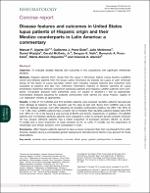| dc.contributor.author | Ugarte-Gil, Manuel F. | |
| dc.contributor.author | Pons-Estel, Guillermo J. | |
| dc.contributor.author | Molineros, Julio | |
| dc.contributor.author | Wojdyla, Daniel | |
| dc.contributor.author | McGwin, Gerald | |
| dc.contributor.author | Nath, Swapan K. | |
| dc.contributor.author | Pons-Estel, Bernardo A. | |
| dc.contributor.author | Alarcón-Riquelme, Marta | |
| dc.contributor.author | Alarcón, Graciela S. | |
| dc.date.accessioned | 2019-04-11T21:35:40Z | |
| dc.date.available | 2019-04-11T21:35:40Z | |
| dc.date.issued | 2016 | |
| dc.identifier.citation | Rheumatology. 2016; 55(3). | es_PE |
| dc.identifier.uri | https://hdl.handle.net/20.500.12959/268 | |
| dc.description.abstract | Objective. To evaluate disease features and outcomes in two populations with significant Amerindian
ancestry.
Methods. Hispanic patients (from Texas) from the Lupus in Minorities: Nature versus Nurture (LUMINA)
cohort and Mestizo patients from the Grupo Latino Americano De Estudio del Lupus or Latin American
Group for the Study of Lupus (GLADEL) cohort were included. Disease features and outcomes were
evaluated at baseline and last visit. Admixture informative markers of Mestizo Genoma de Lupus
Eritematoso Siste´ mico Network consortium (GENLES) patients and Hispanic LUMINA patients were compared. Univariable analyses were performed using Chi square or Student’s t test as appropriate.
Multivariable analyses adjusting for possible confounders were carried out using Poisson, logistic or
Cox regression models as appropriate.
Results. A total of 114 LUMINA and 619 GLADEL patients were included. GLADEL patients had accrued
more damage at baseline, but the opposite was the case at last visit. Being from LUMINA was a risk
factor for damage accrual, even after adjusting for possible confounders [relative risk (RR) 1.33, 95% CI
1.12, 1.58]. Also, LUMINA patients have a higher risk of mortality than GLADEL patients [hazard ratio (HR)
2.37, 95% CI 1.10, 5.15], having 5-year survival of 85.6% and 94.5%, respectively. In addition, 79 LUMINA
patients and 744 Mestizo GENLES patients were evaluated in order to compare genetic ancestry between
the two groups; GENLES patients had a higher proportion of European ancestry (48.5% vs 43.3%,
P = 0.003) and a lower proportion of Asian ancestry (3.7% vs 4.9%, P = 0.048), but the proportions of
Amerindian and African ancestry were comparable in both.
Conclusion. USA Hispanic patients seemed to have a poorer prognosis than their counterparts from Latin
America, despite having a comparable genetic background. Socioeconomic factors may account for these
observations. | |
| dc.description.abstract | Objetivo. Evaluar las características y los resultados de la enfermedad en dos poblaciones con ascendencia amerindia significativa.
Métodos. Se incluyeron pacientes hispanos (de Texas) de la cohorte Lupus in Minorities: Nature versus Nurture (LUMINA) y pacientes mestizos del Grupo Latino Americano De Estudio del Lupus o Latin American Group for the Study of Lupus (GLADEL). Las características y los resultados de la enfermedad se evaluaron al inicio y en la última visita. Se compararon marcadores informativos mixtos de pacientes del consorcio de la Red Genoma de Lupus Eritematoso Sistémico Mestizo (GENLES) y pacientes hispanos de LUMINA. Los análisis univariables se realizaron mediante la prueba de Chi cuadrado o la t de Student , según correspondiera. Se realizaron análisis multivariables ajustando posibles factores de confusión utilizando modelos de regresión de Poisson, logístico o de Cox, según correspondiera.
Resultados. Se incluyeron un total de 114 pacientes LUMINA y 619 GLADEL. Los pacientes de GLADEL habían acumulado más daño al inicio del estudio, pero ocurrió lo contrario en la última visita. Ser de LUMINA fue un factor de riesgo para la acumulación de daños, incluso después de ajustar por posibles factores de confusión [riesgo relativo (RR) 1,33; IC del 95 %: 1,12, 1,58]. Además, los pacientes con LUMINA tienen un mayor riesgo de mortalidad que los pacientes con GLADEL [cociente de riesgo (HR) 2,37; IC del 95 %: 1,10, 5,15], con una supervivencia a 5 años del 85,6 % y 94,5 %, respectivamente. Además, se evaluaron 79 pacientes LUMINA y 744 pacientes Mestizos GENLES para comparar la ascendencia genética entre los dos grupos; Los pacientes de GENLES tenían una mayor proporción de ascendencia europea (48,5% vs 43,3%, P = 0,003) y una menor proporción de ascendencia asiática (3,7% vs.4,9%, P = 0,048), pero las proporciones de ascendencia amerindia y africana fueron comparables en ambos.
Conclusión. Los pacientes hispanos de EE.UU. parecían tener un peor pronóstico que sus homólogos de América Latina, a pesar de tener antecedentes genéticos comparables. Los factores socioeconómicos pueden explicar estas observaciones. | |
| dc.format | application/pdf | es_PE |
| dc.language.iso | eng | es_PE |
| dc.publisher | British Society for Rheumatology | es_PE |
| dc.relation.uri | https://academic.oup.com/rheumatology/article/55/3/436/1793019 | |
| dc.rights | info:eu-repo/semantics/openAccess | es_PE |
| dc.rights.uri | https://creativecommons.org/licenses/by-nc-nd/4.0/ | es_PE |
| dc.source | Seguro Social de Salud (EsSalud) | es_PE |
| dc.source | Repositorio Institucional EsSalud | es_PE |
| dc.subject | Genética humana | es_PE |
| dc.subject | Lupus Eritematoso Sistémico | es_PE |
| dc.subject | Predisposición Genética a la Enfermedad | es_PE |
| dc.subject | Systemic lupus erythematosus | |
| dc.subject | Ethnic group | |
| dc.subject | Genetic predisposition to disease | |
| dc.title | Disease features and outcomes in United States lupus patients of hispanic origin and their mestizo counterparts in Latin America: a commentary. | es_PE |
| dc.title.alternative | Características y resultados de la enfermedad en pacientes con lupus de origen hispano en Estados Unidos y sus homólogos mestizos en América Latina: un comentario | |
| dc.type | info:eu-repo/semantics/article | es_PE |
| dc.subject.ocde | https://purl.org/pe-repo/ocde/ford#3.05.00 | es_PE |
| dc.publisher.country | PE | es_PE |
| dc.identifier.doi | https://doi.org/10.1093/rheumatology/kev280 | |






